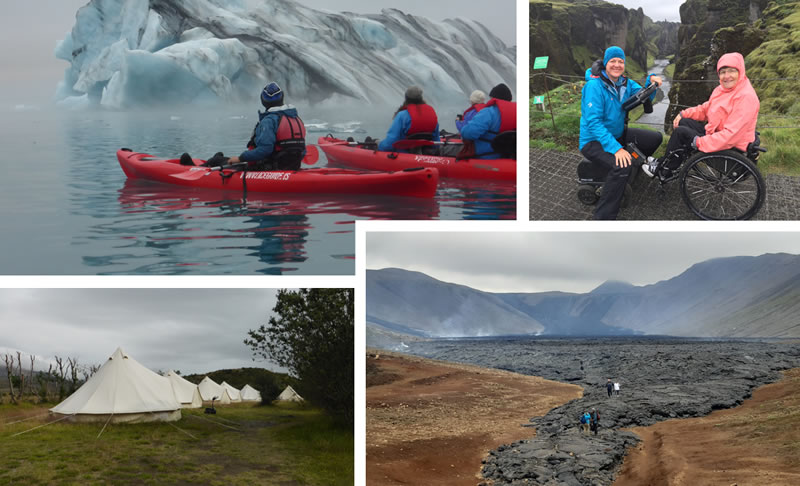Adventure Iceland – an island of fire and ice (part 2)
In the last blog post, we published the first part of the travel report about Gerda Pamler’s trip to Iceland. The sequel is about the second part of the trip, in which she explored more unforgettable highlights that Iceland has to offer for our readers.
SEQUEL…
From Gerda Pamler
The path to the open-air museum Stöng is also easily manageable with a wheelchair. From here you have a great view to the south. The Stöng farm was buried during the eruption of Hekla in 1104 and excavated again in 1939. The excavation site of the Stöng farm ruins is covered and not wheelchair accessible inside, but the path there is very beautiful.
For the next big adventure, we hired a jeep with a driver. We wanted to go to Pórsmörk, a green oasis in the stony desert of the highlands. Around the Eyjafjallajökull, Mýrdalsjökull, and Tindfjallajökull glaciers stretches a beautiful mountain and valley landscape in one of Iceland’s most popular hiking areas. The drive down into the valley took us through several rivers and difficult fords. The notorious Krossa has already swept away some tourists. That’s why we travelled with a professional who crosses these rivers every day. It was an adventure how he slowly steered the big jeep through the rivers – but also getting into the big jeep itself was an adventure. Later we stayed at Volcano Huts in a so-called glamping tent (with heating!), which was mostly accessible with a wheelchair. I was the first wheelchair user in this resort, so they built extra ramps for me – very kind.
We drove further along the ring road, there were some waterfalls there. We already knew Seljalandsfoss and Skogafoss from last time. But Gljúfrabúi, hidden in the rock, was interesting. You can walk over stones in the river into a cave, where from above the waterfall rushes out of a hole in the ceiling. I only looked in from the outside.
We had another surprise at our next overnight stay. A wheelchair accessible room was booked near Vik. I had contacted the landlord in advance. I was assured that the new building was completely wheelchair accessible. But I had not mentioned the date of travel. The new building was still a construction site, tools, building materials everywhere and only light bulbs without lamps on the ceiling. The room itself was ready and nice, one of them was wheelchair accessible. They were very nice then, cleaned up a bit and brought us breakfast upstairs, because the old building was not accessible at all. However, it was a bit outrageous to offer a room in the middle of a building site.
On our first trip to Iceland, we were in Vik. The paths to the viewpoint Cape Dyrholaey, the southernmost point of Iceland, are easily accessible. From the cape you have a fantastic view of the striking cliffs in the sea and the wildly romantic black sandy beach of Solheimafjara. We spotted puffins at the bird rock. On the other side of Cape Dyrholaey, Reynisfjara, there is a black beach with a cave made of basalt columns. However, you are warned not to get too close to the water, as the waves are unpredictable. This was not a problem for me though as I can’t go through the deep sand anyway.
Next stop was the spectacular Fjaðrárgljúfur Canyon (Feather Canyon). The river Fjaðrá flows through an approx. 2 km long serpentine gorge, framed by 100-meter-high rock formations covered with shimmering light green moss. Since a Justin Bieber video and some Game of Thrones scenes, the canyon has become very crowded. At times the canyon was even closed, because tourists were trampling all over the sensitive vegetation. In the meantime, the path at the upper end of the canyon has been expanded and secured with gates.
There are many fantastic views into the canyon. At the end of the gorge is a viewing platform with a view of Mögárfoss, which plunges into the turquoise-blue river Fjadra. At the top of the viewing platform is an official wheelchair parking area. The flat path is not easy because of the rough gravel. With the Swisstrac, I can even get up the steep path from the lower car park.
In Iceland, 10% of the country is covered with ice. At 8,100 km2, Vatnajökull is the largest glacier in Europe. There are some active volcanoes beneath it. It has about 30 glacier tongues, each with a different name. The Skaftafell National Park at Skaftafellsjökull was also a must-see this time. From the visitor centre, we hiked to the glacier tongue on a path signposted for wheelchair users, through vegetation with blueberries and cranberries. We couldn’t believe our eyes when we came to the lagoon with floating icebergs that didn’t exist 11 years ago. We were told that the glaciers recede by about 100 meters every year.
For the next day we had booked a kayak tour on the Jökulsárlón glacier lagoon. The organizer Iceguides offers stable seats on top. We started dressed in several layers of warm clothing under the dry suit, hat, and gloves. We had a very mystical mood when suddenly a huge iceberg emerged from the fog. The absolute highlight of our trip was paddling in an ice cave on Heinabergslón. It was incredible how blue and smooth the ice is inside.
A visit to the currently active volcano Fagradalsfjall, only 15 kilometers from the airport, crowned the end of our trip. Unexpectedly, we reached the lava tongue relatively easily with the Swisstrac. As many visitors come to see this spectacle, there are four hiking trails, some of them up to the top with a view of the volcanic cone. A local told us that there is always a traffic jam when a volcano erupts. Not because everyone wants to leave, but because everyone wants to come. We hiked up to the lava tongue, which was also very impressive. It is amazing how big the area is that is covered with fresh lava. It was still smoking in some places, but the fumes soon let us roll back.
We had a wonderful, adventurous, and definitely not cheap trip. But one thing is for sure: we will be back.
Teleflex thanks Gerda Pamler for this very interesting travel report. We are already looking forward to the reports of the next adventures.
Image and text source: Gerda Pamler



